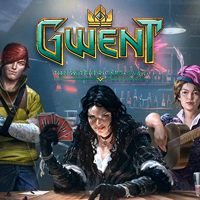Positions of Cards | Card Types
Last update:
Every unit can be deployed to a specific row. While building your deck, it's important to make it various and choose your units in a way that lets you fill every row. If your deck has only melee cards and your opponent plays Frost, you're as good as defeated. With a varied army, one weather effect might be insufficient to win the battle. Moreover, when playing cards, you have to take synergies into account. For example, Vran Warrior devours the unit on the right.

Then, it devours another unit every two turns, so if you place a Gold card on its right side, Vran Warrior becomes useless. The same goes for Event cards, like Commander's Horn, which boosts 5 adjacent units by 4 points. When playing your units, you have to make sure that the enemy won't be able to eliminate an entire row with a single Event card. Try to separate the key units with other ones or play them to different rows to make the game more difficult for the opponent.
Melee units

Melee units can be recognized by the sword icon right under the attack point number. All cards of this type are deployed to the first row.
Ranged units

Ranged units have a crossbow icon. They are deployed to the second row in the middle.
Siege units/engines

Siege units are deployed to the third row in the rear of the army and can be recognized by the catapult icon.
Universal cards

In Gwent, there are also cards that have no specific place on the board and can be played to any row. These cards can be recognized by the icon with looped arrows. These units are very versatile and can be played in a way that lets them avoid bad weather effects currently on the board.
Spies

Spies are cards that you send to your opponent's side. You can recognize them by the red eye icon. These cards add attack points to the opponent's pool but in turn provide an additional effect to the player who plays them, such as drawing of an extra card, weakening enemy units, or moving the strongest unit in the row to your side after a certain number of turns. Thanks to these cards, you can gain another turn by drawing a card and thus making the enemy pass the round and then turn in your favor. You should use spies carefully in order not to thwart your own plans.
Ambushes

Ambushes are played to the opponent's side of the board. Once activated, a specific effect is triggered, for example: weakening all units in a given row by 3 points.
Events

Events are cards that trigger additional effect on the board, a negative or a positive one. They are divided into the following groups:
1. Special cards - You trigger another action, such as decreasing the opponent's units' strength, drawing extra cards, boosting your own units, or resurrecting units from the graveyard.
2. Elixirs - They increase your units' strength, give them armor, or reduce the opponent's units' armor.
3. Weather cards - Playing them causes a negative weather effect in a given row:
- Frost - Reduces the Power of all Melee units by 1 point each turn (aside from Gold cards or those immune to weather effects)
- Fog - Spawn a Fog effect on selected row that decreases the strength of the highest, non-immune units on that row by two each turn. Also, some units benefit from Fog, for example: Foglets.
- Rain - Reduces the Power of the weakest units in a given row by 2 points every turn (aside from Gold cards and the immune ones).
- Storm - Reduces the Power of the leftmost units in a given row by 3, 2, and 1 point, respectively, every turn (aside from Gold cards).
- Hailstorm - Damages all units in a given row by half their Power (aside from Gold cards).
- Ragh Nar Roog - Creates Ragh Nar Roog in all rows on the opponent's side of the board. Every round, the strongest unit in every row is damaged by 2 points.
The aforementioned weather effects can be neutralized with First Light or units that have such an ability, like in the case of Archgriffin (Monsters), Blue Stripes Scout (Northern Kingdoms), or Nauzicaa Standard Bearer (Nilfgaard).
You are not permitted to copy any image, text or info from this page. This site is not associated with and/or endorsed by the or CD Projekt RED. All logos and images are copyrighted by their respective owners.
Copyright © 2000 - 2025 Webedia Polska SA for gamepressure.com, unofficial game guides, walkthroughs, secrets, game tips, maps & strategies for top games.
